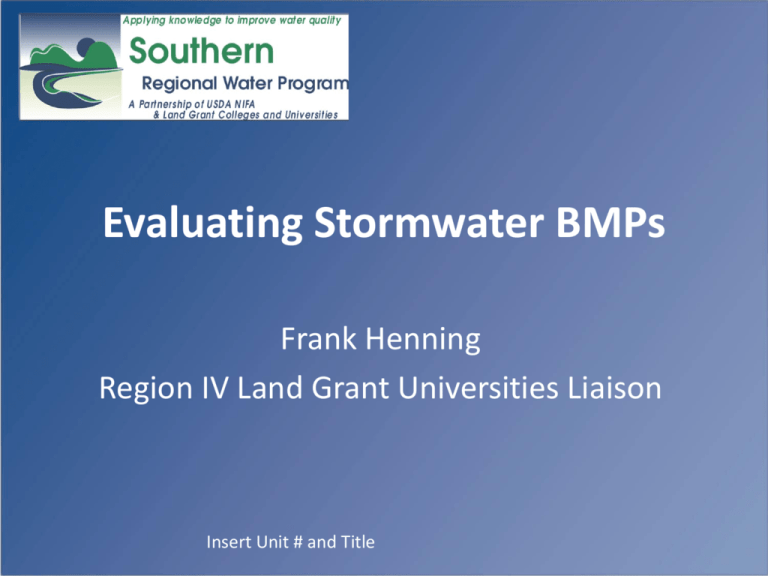BMP Evaluation (ppt)
advertisement

Evaluating Stormwater BMPs Frank Henning Region IV Land Grant Universities Liaison Insert Unit # and Title What Low Impact Development Is and Is Not LID Is: LID Is Not: Volume control for small storms Major flood control Better stormwater management for new & existing development Anti-development Requires complementary approaches for large storms A stand-alone solution for all wet weather management Scale site specific solution One size fits all Mimics natural hydrology Dry up all the streams Cost competitive to traditional stormwater management Free Stormpond Design Volumes Georgia Stormwater Management Manual, Vol. 2 ARC 2001 Water Quality Volume Knoxville, TN Development Manual Reducing Runoff Volume 6 Flow Volume Green Infrastructure/LID – Preserves natural environments – Retains stormwater volume for infiltration, evapotranspiration, or use – Removes the volume from the stream – Mimics natural hydrology, often enhances groundwater recharge and base flow – Removes pollutant load associated with the volume retained – Does not transfer pollution to ground water – May need additional storage to address stream protection and flood prevention requirements Natural Area Preservation Soils and vegetation – already present = free Inlet/Outlet control – direct inflow/overland flow = free Storage volume = predevelopment conditions Natural areas generally are counted as net zero Can they store, infiltrate, evapotranspirate more than the design volume? Wetlands Franklin, TN Maryville TN Buffers Maryville TN Springhead Soil Enhancement Program • Cost – usually minimal or low • Storage – enhance void space and infiltration rate of soil • Soil – amended soil and native soil infiltration rate • Vegetation – selection based on site • Inlet/Outlet – direct inflow, overland or directed Vegetative Cover Reduce Pollutant Loads -Proper fertilizer and pesticide use -Maintain vegetative cover -BMP is a nutrient sink, not a nutrient source (how green is green?) -Stormwater contains nutrients Disconnection Programs • Storage – based voids, and infiltration rate of soil, impervious area disconnected (capture area) • Soils – amended or uncompacted native soil • Vegetation – selection based on the site • Inlet/Outlet – downspouts, sheet flow over vegetated areas to swales, sewers, waterbodies Tree Canopy Programs • Storage volume - based on pool volume, void space of amended soil, native soil infiltration rate, evapotranspiration rate, capture area • Soil – structural or amended for storage/pollutant uptake • Vegetation - trees for largest amount of evapotranspiration, other benefits • Inlet /Outlet Controls – must provide! Rainwater Harvesting & Use • • • • • • Storage volume – Water Use – irrigation or other use Soils - infiltration Vegetation – evapotranspiration Inlet/Outlet - must be provided Outlet protection – reduce erosion Green Parking – Permeable Pavement Green Roofs • Storage – soil depth/voids • Soils – amended, structured • Vegetation – intensive (shallow soilsedums or drought tolerant species) or extensive (deep soil-small tree, shrubs) • Inlet /Outlet – direct capture/roof drains • Structural – must perform analysis Raingardens/Bioretention • Storage Volume – based on pool design, amended soil void space, capture area • Soils - native soils are removed and replaced with amended soil • Vegetation - herbaceous (low evapotranspiration) • Inlet/ Outlet controls - direct inflow and provide for bypassing larger events Volume Comparison Burnsville, MN Neighborhood Rain Garden Study Barr Engineering Other GI/LID Benefits • • • • • • • Air quality improvement Community beautification Energy savings Health benefits Heat island reduction Property value improvement Recreation and wildlife Acknowledgements Module contributors: Material for this module was adapted from presentations and publications by Region IV EPA Watershed Protection Division Module editors: [Insert names and affiliations here for at least 2 peer-reviewers] Southern Region Landscape Team: Amy Shober (UF/IFAS); Lucy Bradley (NCSU); Eve Brantley (Auburn); Wendi Hartup (NCSU); Barbara Fair (NCSU); Frank Henning (USEPA/UGA); Esen Momol (UF/IFAS); Kerry Smith (Auburn); Dotty Woodson (Texas Agrilife); Sheryl Wells (UGA) Funding for this module provided by: USDA-NIFA National Water Program, Southern Regional Water Program special project funds Graphic design: Emily Eubanks - UF/IFAS Center for Landscape Conservation and Ecology; Amy L. Shober – UF/IFAS Gulf Coast Research and Education Center 21







